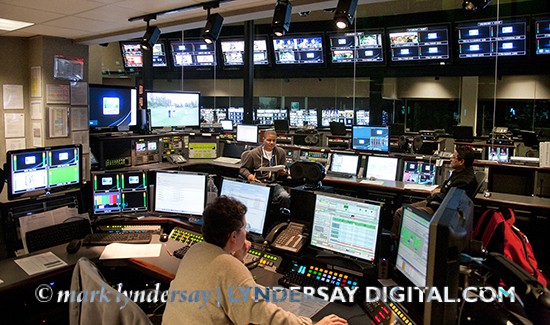DirecTV's push into Latin America
11/04/11 20:36 Filed in: Technology
DirecTV’s push into Latin America
Story and photos by Mark Lyndersay.
Originally published in the Business Guardian, April 07, 2011

Transmission monitoring suites at DirecTV’s Los Angeles Broadcast Center. Photo by Mark Lyndersay.
It’s late on the first day of a tour of the El Segundo facilities of DirecTV and the media group, drawn from several key markets in Latin America, is being ushered into a conference room at the company’s Los Angeles Broadcast Center.
It’s an impressive space, with a curved ceiling and windows all around that cantilever outward as they rise to the ceiling. We are seated at a 20 foot long polished wood table for a short introduction and then I hear someone mutter, “Chris loves this part.”
At that moment, there is a hard clicking sound and a steady mechanical hum as the white shutters over the windows slowly rise to reveal hundreds of screens in the rooms one floor below us and circling this space, all flickering with images.
This is where the incoming feeds are edited, organised and broadcast to the seventeen satellites in geosynchronous orbit above the equator serving North and South America.
But really, it’s a scene right out of a 1970’s Bond movie, and you have to wonder if this isn’t the room where the jefes of DirecTV hatch their plans for pay television domination.
The company is going to need all the thinking it can muster to keep its lead in aggressively competitive markets. DirecTV jockeys for lead position in the US with Comcast, among cable television providers in the US and dominates that country’s satellite television market.
DirecTV has a natural advantage where territory makes it difficult to run physical connections and offers products for vehicles and yachts and recently introduced in-flight pay-TV on Continental airlines.
Almost a third of the company’s customer base is in Latin America, but the company earns roughly half the income per customer outside the US, partly due to differences in pricing and customer income potential, and partly because of to challenges from externalities like pervasive movie piracy and signal theft.
The company sees the region as primed for growth and plans to adapt and roll out the technological advancements its proven in the US market to the Latin American region.
In Trinidad and Tobago, DirecTV cites Telecommunications Authority data that positions the local arm of the service at 15 percent of 175,000 pay-TV households giving it a customer base of just over 25,000 subscribers.
The DirecTV of today has travelled a dramatic corporate route since its founding in 1994. DirecTV in both the US and in Latin America went through multiple ownerships, share sales and mergers before becoming a unified company in 2010, headquartered in El Segundo, California.
The DirecTV service in Trinidad and Tobago launched as a franchise in the Caribbean by CCN under an operating agreement with Galaxy Latin America. The franchise was sold in 2001 and DirecTV Caribbean became a full subsidiary of DirecTV Latin America.
The parent company, with annual revenues of US$24 billion, operates three key subsidiaries, DirecTV US, with 19.2 million subscribers and revenues of US$20 billion, DirecTV Latin America, with 8.9 million subscribers and revenues of US$3.6 billion and Sports Networks with 8.5 million subscribers and revenues of US$237 million.
In second quarter of 2010, according to Jose Rocha, Vice President for Operations and Production, DirecTV added 515,000 new subscribers, reported 26 million customers in the US, Latin America and Mexico and grew revenues by 12 percent to US$5.85 billion.
This in the face of markets that are leveraging Internet connectivity to offer triple play solutions to deliver a range of services to cable connected customers, beginning with, but not limited to, telephony and web connections in addition to the streams of news and entertainment offered in typical pay-TV packages.
At least part of this success is attributable to DirecTV’s determination to stick to its knitting. The spectre of DirecPC is now firmly in the company’s past, a legacy of its Hughes days, and at the LA Broadcast Center, home of the James Bond room, the company was keen to show off the technology behind their broadcast capacity.
The broadcast centre, one of five installations, gathers streams from its content providers before compressing them in MP4 format and transmitting the data to overhead satellites.
In several of the hardware packed suites are the editing centres that DirecTV uses for its live sports programming, increasingly a cornerstone of the line-up that serves to distinguish it from its competition.
In one empty editing room, a demo of the “mosaic” screen, a graphic framing multiple live video streams has been left running, gathering feeds from partner cameras as well as unique POV cameras set by DirecTV for the upcoming Master’s Golf championship.
The tour threads through one of the six rooms that handle the incoming feeds and compression. The room is roughly one fifth of a football field in size, with parallel racks running what seem to be dozens of off-the-shelf DVR devices and Dell PowerEdge blade servers in alternating rows, all served by bundles of cabling the thickness of a Chippendale dancer’s thigh.
Then it’s outside in the brisk California air, even chillier under an overcast sky, into two football fields worth of antenna farms, some small, some massive, one a funky squarish shape, all aimed at satellites miles overhead.
The company has been in business long enough to be running into the lifespan limits of some of its earliest satellites and the US region has already had some replaced. It takes roughly 15 years for these orbiting retransmitters to burn through the fuel they carry for their repositioning jets.
Newer satellites, noted Gunter Kamper, Vice President of Broadcast Operations, Latin America, will incorporate new technology designed to focus a stronger signal in more populated areas and those with a history of poor weather and heavy rain, the kryptonite of service quality.
With a satellite costing up to US$600 million each, DirecTV has been reworking its technology to make better use of its existing satellites and Kamper, ducking the queries of the assembled press, would only commit to saying that “every year, DirecTV will add more channels.”
New satellites will certainly be designed to handle more high definition capacity, a key selling point of the company’s service.
Rômulo Pontual, Chief Technology Officer, stopped short of dismissing the more commonly available 720p transmissions, but emphasised that DirecTV’s commitment was to what it called True HD, 1080p all-digital signal from capture to final transmission.
With most new television sets capable of viewing the richer high definition signal, DirecTV is clearly gambling that its signal will match customer expectations for their new screens.
The company is also rolling the dice on 3D programming and collaborated with Panasonic to the tune of US$20 million in producing original 3D content during 2010.
All DirecTV boxes can access 3D content and some samples of sports transmitted in 3D were offered as examples of what’s possible.
Despite Pontual’s insistence that “3D is selling more today than HD was in the beginning,” this is a technology, on the evidence of my own eyes, that’s still very much in development.
More compelling technology announcements included a very capable iPad app for the DirecTV box (iPhone and Android apps will follow) which offers the controls of a remote but also builds in attractive content browsing and some trailers for current and upcoming films.
The DirecTV box now supports apps as well, which allow users more onscreen control of the device and add services, such as being able to post canned messages about what they are viewing to Facebook and Twitter and to “like” the content onscreen.
Both features require wireless connectivity and Internet access, features that aren’t available in a device that executives were describing as a “basebox,” a cheaper DirecTV box aimed at customers with less discretionary income that eliminates HD and network capabilities while reducing the cost to the consumer by 25 percent.
Much of what the DirecTV team showed during the two day LA tour was a mix of what’s been working well for them in the past and solutions that seem to address market weaknesses, but there’s nothing to suggest that the company has any plans to lose its focus on its programming line-up and its successes in sports.
After transmitting the World Cup 2010 in high definition with a 5.1 sound signal, DirecTV plans to increase the 3,000 hours of original production it does each year. The company already claims 56 hours of live sports per month, compared to ESPN’s 14, and intends to deepen its coverage of Latin American sport, adding local commentators to different regions as appropriate. Between 60 to 70 percent of sports programming for Latin America is soccer and the onscreen sports guide carries scores from multiple games simultaneously.
The onscreen mosaics of action were a big hit for the company during the world cup, enabling customers to follow multiple games at the same time and the company is already making plans or the next Olympiad.
“The difference will be in capacity,” said Jose Rocha, “and what DirecTV is able to do with it.”
“A fan of sports is usually a fan of two or three sports, not all of them and the Olympics gives you so much to work with. It can be as much as 12 hours, moving from one sport to another. It’s an opportunity to work with sports all day.”
The sense you leave the DirecTV team with is of a group that know’s what’s worked in the past and what’s likely to work next and their plans are laid in alignment with that history.
The strategy has kept them in the game in the face of redoubled competition from cable providers and the successes of the larger operations feed directly down to Latin America and smaller markets like Trinidad and Tobago.
With the exception of 3D, virtually nothing on show in LA was anything but practical and you could almost hear the guys impatiently clicking their knitting needles, waiting to get going on the next bold digital tapestry.
DirecTV in Trinidad
In response to e-mailed questions about competitive aspects of the company’s local operations, Bernard Pantin, General Manager of DirecTV Trinidad sent the following response...
“As the leading satellite television provider in the world, DirecTV is committed to providing the best pay-TV services in the Caribbean and enhancing viewers video experience. The company will continue to explore bundling opportunities with existing broadband providers throughout the region.
However the immediate focus of the company will continue to be based on providing superior customer service and field services.
All new DirecTV customers receive installation within 72 hours, while more than 90 percent of all technical assistance is provided within 48 hours.
The company will also continue to lead the way in content and technology. Through its relationship with DTVLA and DirecTV US, DirecTV Caribbean has access to cutting edge pay-TV technology including the DVR and HD DVR boxes at most affordable pay-TV prices.
DIRECTV also now has a lower monthly basic package than the main pay-TV provider in T&T – Flow.”
Story and photos by Mark Lyndersay.
Originally published in the Business Guardian, April 07, 2011

Transmission monitoring suites at DirecTV’s Los Angeles Broadcast Center. Photo by Mark Lyndersay.
It’s late on the first day of a tour of the El Segundo facilities of DirecTV and the media group, drawn from several key markets in Latin America, is being ushered into a conference room at the company’s Los Angeles Broadcast Center.
It’s an impressive space, with a curved ceiling and windows all around that cantilever outward as they rise to the ceiling. We are seated at a 20 foot long polished wood table for a short introduction and then I hear someone mutter, “Chris loves this part.”
At that moment, there is a hard clicking sound and a steady mechanical hum as the white shutters over the windows slowly rise to reveal hundreds of screens in the rooms one floor below us and circling this space, all flickering with images.
This is where the incoming feeds are edited, organised and broadcast to the seventeen satellites in geosynchronous orbit above the equator serving North and South America.
But really, it’s a scene right out of a 1970’s Bond movie, and you have to wonder if this isn’t the room where the jefes of DirecTV hatch their plans for pay television domination.
The company is going to need all the thinking it can muster to keep its lead in aggressively competitive markets. DirecTV jockeys for lead position in the US with Comcast, among cable television providers in the US and dominates that country’s satellite television market.
DirecTV has a natural advantage where territory makes it difficult to run physical connections and offers products for vehicles and yachts and recently introduced in-flight pay-TV on Continental airlines.
Almost a third of the company’s customer base is in Latin America, but the company earns roughly half the income per customer outside the US, partly due to differences in pricing and customer income potential, and partly because of to challenges from externalities like pervasive movie piracy and signal theft.
The company sees the region as primed for growth and plans to adapt and roll out the technological advancements its proven in the US market to the Latin American region.
In Trinidad and Tobago, DirecTV cites Telecommunications Authority data that positions the local arm of the service at 15 percent of 175,000 pay-TV households giving it a customer base of just over 25,000 subscribers.
The DirecTV of today has travelled a dramatic corporate route since its founding in 1994. DirecTV in both the US and in Latin America went through multiple ownerships, share sales and mergers before becoming a unified company in 2010, headquartered in El Segundo, California.
The DirecTV service in Trinidad and Tobago launched as a franchise in the Caribbean by CCN under an operating agreement with Galaxy Latin America. The franchise was sold in 2001 and DirecTV Caribbean became a full subsidiary of DirecTV Latin America.
The parent company, with annual revenues of US$24 billion, operates three key subsidiaries, DirecTV US, with 19.2 million subscribers and revenues of US$20 billion, DirecTV Latin America, with 8.9 million subscribers and revenues of US$3.6 billion and Sports Networks with 8.5 million subscribers and revenues of US$237 million.
In second quarter of 2010, according to Jose Rocha, Vice President for Operations and Production, DirecTV added 515,000 new subscribers, reported 26 million customers in the US, Latin America and Mexico and grew revenues by 12 percent to US$5.85 billion.
This in the face of markets that are leveraging Internet connectivity to offer triple play solutions to deliver a range of services to cable connected customers, beginning with, but not limited to, telephony and web connections in addition to the streams of news and entertainment offered in typical pay-TV packages.
At least part of this success is attributable to DirecTV’s determination to stick to its knitting. The spectre of DirecPC is now firmly in the company’s past, a legacy of its Hughes days, and at the LA Broadcast Center, home of the James Bond room, the company was keen to show off the technology behind their broadcast capacity.
The broadcast centre, one of five installations, gathers streams from its content providers before compressing them in MP4 format and transmitting the data to overhead satellites.
In several of the hardware packed suites are the editing centres that DirecTV uses for its live sports programming, increasingly a cornerstone of the line-up that serves to distinguish it from its competition.
In one empty editing room, a demo of the “mosaic” screen, a graphic framing multiple live video streams has been left running, gathering feeds from partner cameras as well as unique POV cameras set by DirecTV for the upcoming Master’s Golf championship.
The tour threads through one of the six rooms that handle the incoming feeds and compression. The room is roughly one fifth of a football field in size, with parallel racks running what seem to be dozens of off-the-shelf DVR devices and Dell PowerEdge blade servers in alternating rows, all served by bundles of cabling the thickness of a Chippendale dancer’s thigh.
Then it’s outside in the brisk California air, even chillier under an overcast sky, into two football fields worth of antenna farms, some small, some massive, one a funky squarish shape, all aimed at satellites miles overhead.
The company has been in business long enough to be running into the lifespan limits of some of its earliest satellites and the US region has already had some replaced. It takes roughly 15 years for these orbiting retransmitters to burn through the fuel they carry for their repositioning jets.
Newer satellites, noted Gunter Kamper, Vice President of Broadcast Operations, Latin America, will incorporate new technology designed to focus a stronger signal in more populated areas and those with a history of poor weather and heavy rain, the kryptonite of service quality.
With a satellite costing up to US$600 million each, DirecTV has been reworking its technology to make better use of its existing satellites and Kamper, ducking the queries of the assembled press, would only commit to saying that “every year, DirecTV will add more channels.”
New satellites will certainly be designed to handle more high definition capacity, a key selling point of the company’s service.
Rômulo Pontual, Chief Technology Officer, stopped short of dismissing the more commonly available 720p transmissions, but emphasised that DirecTV’s commitment was to what it called True HD, 1080p all-digital signal from capture to final transmission.
With most new television sets capable of viewing the richer high definition signal, DirecTV is clearly gambling that its signal will match customer expectations for their new screens.
The company is also rolling the dice on 3D programming and collaborated with Panasonic to the tune of US$20 million in producing original 3D content during 2010.
All DirecTV boxes can access 3D content and some samples of sports transmitted in 3D were offered as examples of what’s possible.
Despite Pontual’s insistence that “3D is selling more today than HD was in the beginning,” this is a technology, on the evidence of my own eyes, that’s still very much in development.
More compelling technology announcements included a very capable iPad app for the DirecTV box (iPhone and Android apps will follow) which offers the controls of a remote but also builds in attractive content browsing and some trailers for current and upcoming films.
The DirecTV box now supports apps as well, which allow users more onscreen control of the device and add services, such as being able to post canned messages about what they are viewing to Facebook and Twitter and to “like” the content onscreen.
Both features require wireless connectivity and Internet access, features that aren’t available in a device that executives were describing as a “basebox,” a cheaper DirecTV box aimed at customers with less discretionary income that eliminates HD and network capabilities while reducing the cost to the consumer by 25 percent.
Much of what the DirecTV team showed during the two day LA tour was a mix of what’s been working well for them in the past and solutions that seem to address market weaknesses, but there’s nothing to suggest that the company has any plans to lose its focus on its programming line-up and its successes in sports.
After transmitting the World Cup 2010 in high definition with a 5.1 sound signal, DirecTV plans to increase the 3,000 hours of original production it does each year. The company already claims 56 hours of live sports per month, compared to ESPN’s 14, and intends to deepen its coverage of Latin American sport, adding local commentators to different regions as appropriate. Between 60 to 70 percent of sports programming for Latin America is soccer and the onscreen sports guide carries scores from multiple games simultaneously.
The onscreen mosaics of action were a big hit for the company during the world cup, enabling customers to follow multiple games at the same time and the company is already making plans or the next Olympiad.
“The difference will be in capacity,” said Jose Rocha, “and what DirecTV is able to do with it.”
“A fan of sports is usually a fan of two or three sports, not all of them and the Olympics gives you so much to work with. It can be as much as 12 hours, moving from one sport to another. It’s an opportunity to work with sports all day.”
The sense you leave the DirecTV team with is of a group that know’s what’s worked in the past and what’s likely to work next and their plans are laid in alignment with that history.
The strategy has kept them in the game in the face of redoubled competition from cable providers and the successes of the larger operations feed directly down to Latin America and smaller markets like Trinidad and Tobago.
With the exception of 3D, virtually nothing on show in LA was anything but practical and you could almost hear the guys impatiently clicking their knitting needles, waiting to get going on the next bold digital tapestry.
DirecTV in Trinidad
In response to e-mailed questions about competitive aspects of the company’s local operations, Bernard Pantin, General Manager of DirecTV Trinidad sent the following response...
“As the leading satellite television provider in the world, DirecTV is committed to providing the best pay-TV services in the Caribbean and enhancing viewers video experience. The company will continue to explore bundling opportunities with existing broadband providers throughout the region.
However the immediate focus of the company will continue to be based on providing superior customer service and field services.
All new DirecTV customers receive installation within 72 hours, while more than 90 percent of all technical assistance is provided within 48 hours.
The company will also continue to lead the way in content and technology. Through its relationship with DTVLA and DirecTV US, DirecTV Caribbean has access to cutting edge pay-TV technology including the DVR and HD DVR boxes at most affordable pay-TV prices.
DIRECTV also now has a lower monthly basic package than the main pay-TV provider in T&T – Flow.”
blog comments powered by Disqus


